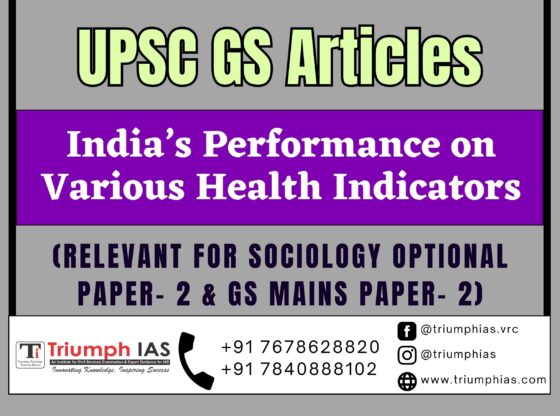India’s Performance on Various Health Indicators
Relevant for sociology optional Paper- 2 & GS Mains Paper- 2

India’s performance on various health indicators has been a topic of discussion for several years. Health is a fundamental aspect of a nation’s development, and India has made significant strides in improving its healthcare system. However, there is still a long way to go to achieve optimal health outcomes for all its citizens.
One of the most crucial indicators of health is life expectancy. In India, life expectancy at birth has been on the rise, increasing from 63.9 years in 2000 to 69.7 years in 2020. This is a positive trend, and it is indicative of the improvements made in healthcare and other social sectors. However, India’s life expectancy is still lower than many developed countries, highlighting the need for continued efforts to improve healthcare infrastructure and access.
Another critical health indicator is infant mortality rate (IMR), which is defined as the number of deaths of children under one year of age per 1,000 live births. India’s IMR has decreased substantially in the past few decades, from 66 deaths per 1,000 live births in 2000 to 28 deaths per 1,000 live births in 2020. This is an impressive improvement, but it is still higher than the global average and the target set by the Sustainable Development Goals (SDGs).
Maternal mortality ratio (MMR) is another crucial indicator of health, representing the number of maternal deaths per 100,000 live births. India’s MMR has also decreased in recent years, from 560 deaths per 100,000 live births in 2006 to 113 deaths per 100,000 live births in 2020. This is a significant improvement, but it is still higher than the global average and the SDG target.
India’s healthcare system faces several challenges, including inadequate healthcare infrastructure, limited access to healthcare services, and disparities in healthcare outcomes among different population groups. Rural areas and economically disadvantaged populations often have limited access to healthcare services, which can result in poor health outcomes. However, the government has implemented several initiatives to address these challenges.
One such initiative is the National Health Mission (NHM), which was launched in 2013 to provide universal access to quality healthcare services, especially in rural areas. The NHM focuses on improving maternal and child health, reducing disease burden, and strengthening health systems. Under the NHM, several programs have been implemented, including the Janani Shishu Suraksha Karyakram (JSSK) and the Rashtriya Bal Swasthya Karyakram (RBSK), which aim to provide free healthcare services to pregnant women and children.
The government has also launched the Ayushman Bharat scheme, which aims to provide financial protection to vulnerable populations by providing them with health insurance coverage. Under this scheme, eligible families can avail of free healthcare services up to a certain limit. This scheme has the potential to significantly improve access to healthcare services for disadvantaged populations.
India has also made significant progress in combating communicable diseases such as tuberculosis (TB) and malaria. The government has implemented several programs, such as the Revised National Tuberculosis Control Programme (RNTCP) and the National Vector Borne Disease Control Programme (NVBDCP), to combat these diseases. As a result, the incidence of TB has decreased from 291 per 100,000 population in 2000 to 193 per 100,000 population in 2020. Similarly, the incidence of malaria has decreased from 2.04 million cases in 2000 to 0.52 million cases in 2020.
Non-communicable diseases (NCDs) such as diabetes and cardiovascular diseases (CVDs) are emerging as significant public health challenges in India. According to the World Health Organization (WHO), NCDs account for 61% of all deaths in India, with CVDs being the leading cause of mortality. This highlights the need for a multi-sectoral approach to address NCDs, including health promotion, prevention, early detection, and management. The government has launched several initiatives to address NCDs, including the National Programme for Prevention and Control of Cancer, Diabetes, Cardiovascular Diseases and Stroke (NPCDCS) and the National Mental Health Programme (NMHP).
The NPCDCS aims to prevent and control NCDs by promoting healthy lifestyles, early detection, and management of NCDs. It focuses on screening and early detection of NCDs, strengthening health infrastructure, and providing free drugs and diagnostics to patients. The NMHP aims to provide mental health services to all citizens and to reduce the treatment gap for mental disorders.
In recent years, India has also witnessed a surge in air pollution, which has emerged as a significant public health challenge. According to the Global Burden of Disease Study, air pollution is responsible for 1.67 million deaths in India each year. The government has launched several initiatives to address air pollution, including the National Clean Air Programme (NCAP) and the Pradhan Mantri Ujjwala Yojana, which aims to provide clean cooking fuel to households.
In conclusion, India’s performance on various health indicators has improved significantly in recent years, but there is still a long way to go to achieve optimal health outcomes for all its citizens. The government has launched several initiatives to address the challenges in the healthcare system, including inadequate infrastructure, limited access to healthcare services, disparities in healthcare outcomes, and emerging public health challenges such as NCDs and air pollution. A multi-sectorial approach is required to address these challenges and to ensure that all citizens have access to quality healthcare services. By continuing to invest in healthcare infrastructure, promoting healthy lifestyles, and implementing innovative healthcare solutions, India can make significant progress towards achieving its healthcare goals.
For more such free UPSC notes, Articles, News & Views Join our Telegram Channel. https://t.me/triumphias
Click the link below to see the details about the UPSC – Civils courses offered by Triumph IAS. https://triumphias.com/pages-all-courses.php


